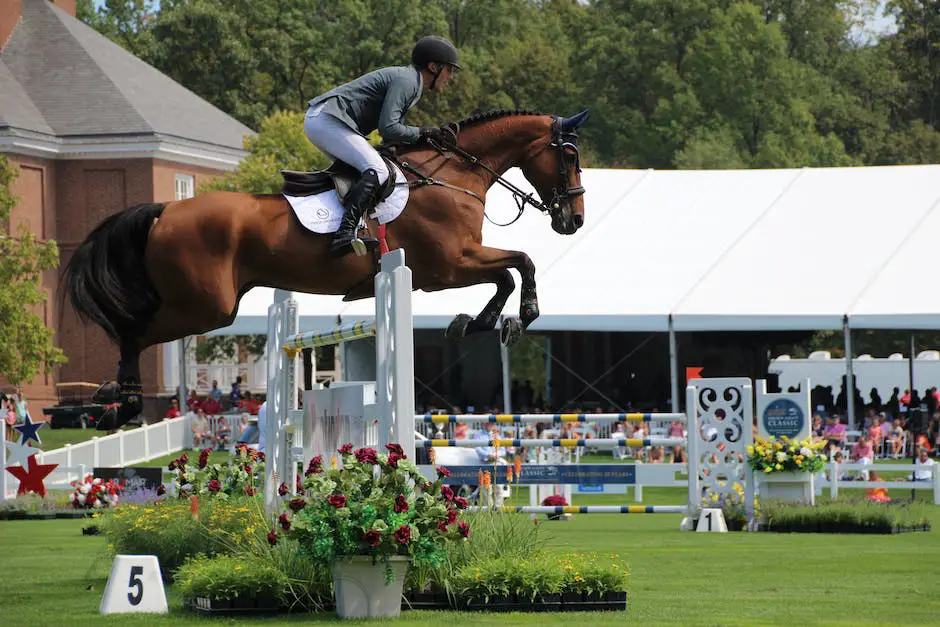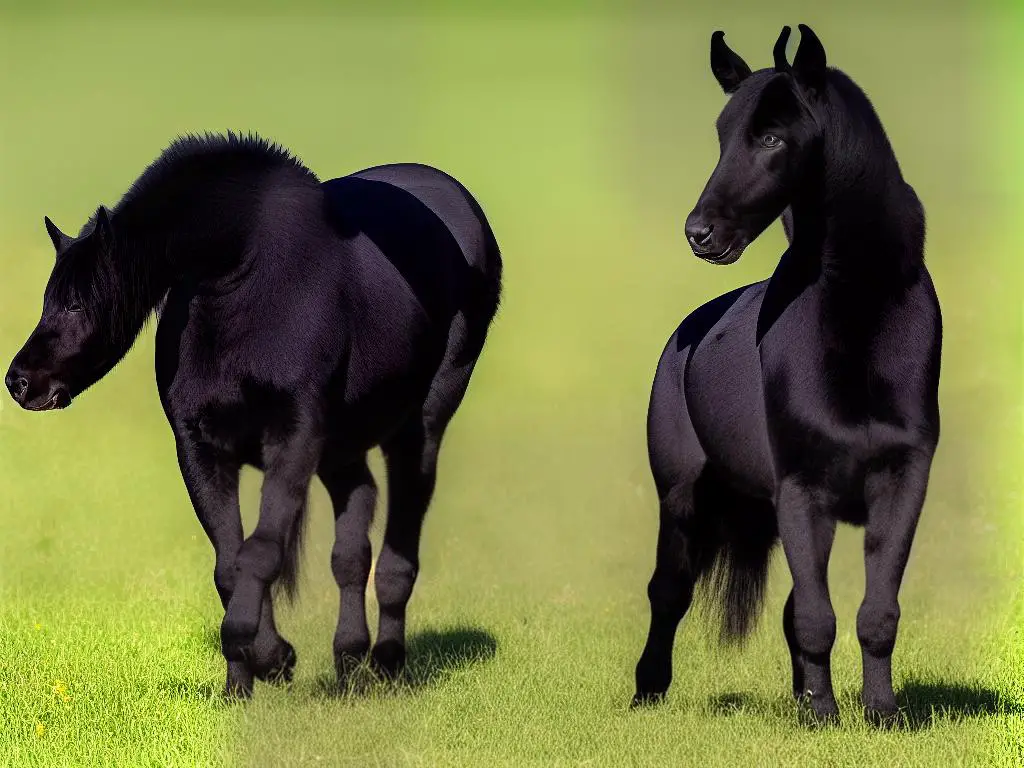When it comes to elegance, athleticism, and versatility, German Warmblood horses are some of the most sought-after equine partners in the world. These majestic animals have a rich history, originating from various German breeds such as Hanoverian, Oldenburg, and Holsteiner. As a prospective buyer, it is essential to become well-informed on what it takes to buy the right German Warmblood, taking into account the specific breed, suitability for purpose, and the overall journey of acquiring your new equine partner.
Table of Contents (Horspedia)
Understanding German Warmblood Breeds
Introduction to German Warmblood Breeds
German Warmblood horses are a group of horse breeds that originated in Germany and were bred for their versatile abilities in sports like dressage, show jumping, and eventing. To help you in your quest to buy a German Warmblood horse, it’s essential first to understand the different breeds and their distinctive characteristics. In this guide, we will discuss the main German Warmblood breeds, such as Hanoverian, Oldenburg, and Holsteiner.
Hanoverian
Hanoverians are one of the most popular and successful German warmblood breeds in the world. They originated from the region of Lower Saxony in Germany, and were initially bred for hardworking farm and carriage horses. Over time, however, Hanoverians shifted their purpose towards sport and performance, excelling in dressage, show jumping, and eventing.
Characteristics
Hanoverians are known for their exceptional athleticism, rhythmic and balanced movement, strong build, and willingness to learn. These horses typically stand between 15.3 to 17.2 hands tall and display a range of solid colors, including black, bay, chestnut, and grey. They possess a well-shaped head with large, expressive eyes, a muscular neck, and a strong, sloping shoulder.
Selecting a Hanoverian
When buying a Hanoverian, consider choosing one that is registered with the American Hanoverian Society or the Verband Hannoverscher Warmblutpferdezüchter (Hanoverian Breeder’s Association in Germany). This ensures that the horse meets the breeding standards for the Hanoverian breed.
Oldenburg
Oldenburg horses are another popular German warmblood breed, originating from the region of Oldenburg in northwest Germany. Initially bred as coach and utility horses, Oldenburgs gained popularity for their moving abilities and excelled in dressage and show-jumping competitions.
Characteristics
Oldenburgs are known for their expressive and elastic movement, power, and grace. They stand between 16 to 17.2 hands tall and can be found in various solid colors. These horses have a refined, intelligent head, a long, powerful neck, and a well-proportioned, strong body.
Selecting an Oldenburg
When looking for an Oldenburg, consider a horse registered with either the International Sporthorse Registry (ISR) Oldenburg, the Oldenburg Horse Breeders’ Society of North America, or the Verband der Züchter des Oldenburger Pferdes (Oldenburg Breeder’s Association in Germany). This ensures that the horse adheres to the breed standards set by these organizations.
Holsteiner
Holsteiner horses are one of the oldest warmblood breeds, originating from the Schleswig-Holstein region of Germany. Historically, they were used as agricultural and military horses, but over time, their breeding focus shifted towards sports – making them exceptional show jumpers and dressage performers.
Characteristics
Holsteiners are known for their powerful, elastic, and ground-covering gaits, as well as their courage and scope in jumping. They typically stand between 16 to 17 hands tall and are most commonly found in bay, grey, or black with minimal white markings. Holsteiners possess a well-proportioned head, a strong neck and shoulder, and a deep, compact body.
Selecting a Holsteiner
When purchasing a Holsteiner, consider choosing one that is registered with the American Holsteiner Horse Association (AHHA) or the Verband der Züchter des Holsteiner Pferdes (Holsteiner Breeder’s Association in Germany). This ensures that the horse meets the breeding requirements for the Holsteiner breed.
Conclusion
Understanding the main German Warmblood breeds, such as Hanoverian, Oldenburg, and Holsteiner, will help you choose the most suitable horse according to your preferences and needs. Ensure that the horse is registered with a reputable organization to guarantee that it meets the breeding standards of the specific breed. With proper research and preparation, you will be well on your way to buying a German Warmblood horse that will excel in your desired discipline.

Choosing the Right Warmblood for Your Needs
Introduction
German warmbloods are a group of versatile, athletic, and cooperative horse breeds originating from Germany. They excel in various equestrian disciplines, such as dressage, showjumping, and eventing. Choosing the right warmblood for your needs requires considering various factors, including your riding goals, experience level, and the horse’s temperament.
Determine Your Discipline
The first step in choosing the right German warmblood is determining which equestrian discipline you wish to pursue. Some popular disciplines include:
- Dressage: Focused on performing precise, elegant, and fluid movements, dressage requires horses with natural balance, suppleness, and responsiveness.
- Showjumping: This discipline involves clearing fences at high speeds and requires horses with power, athleticism, and agility.
- Eventing: Combining dressage, showjumping, and cross country, eventing requires versatile horses with endurance, bravery, and adaptability.
Some German warmblood breeds, such as the Hanoverian and Oldenburg, are versatile and can excel in multiple disciplines. Others, like the Holsteiner or Westphalian, may have a stronger inclination towards specific disciplines like showjumping.
Evaluate Your Rider Experience
It’s vital to consider your riding experience and skill level when choosing a German warmblood. Some warmbloods are ideal for novice riders, while others require more experienced handling. Here are a few suggestions:
- Beginner riders: Seek a calm, forgiving, and well-trained warmblood with plenty of riding experience.
- Intermediate riders: Look for a more sensitive and responsive warmblood that offers opportunities for growth and learning, without being overwhelming.
- Advanced riders: Consider a highly talented and trainable warmblood with the potential to reach top levels of competition in your chosen discipline.
Remember, rider safety is paramount. It’s important to choose a horse that matches your abilities and confidence level.
Assess the Horse’s Temperament
Temperament is a crucial consideration when choosing a German warmblood, as it can impact your riding experience and success in your chosen discipline. Key temperament qualities to consider include:
- Sensitivity: A sensitive horse may be more responsive to cues, but could also become overwhelmed by an inexperienced rider’s mistakes.
- Confidence: A confident horse is more likely to approach new challenges with enthusiasm and bravery, which can be advantageous in eventing or showjumping.
- Work Ethic: Horses with a strong work ethic are typically willing to try their best during training and competitions, making them excellent partners for riders looking to excel in their discipline.
When assessing temperament, interact with the horse on the ground and in the saddle, and observe how it behaves in various situations.
Consult with Professionals
When choosing a German warmblood, it can be helpful to consult with professionals who can offer valuable advice:
- Riding Instructors: Discuss your riding goals with an instructor who can recommend the right type of horse for your needs.
- Horse Trainers: Trainers specializing in your desired discipline can offer insights into a horse’s potential and temperament.
- Veterinarians: Consult with a vet during the pre-purchase exam to ensure the horse is in good health and suitable for your intended use.
By taking the time to consider your goals, experience, and desired traits in a horse, you’re more likely to find the perfect German warmblood for your needs. Happy horse hunting!

Finding Warmblood Breeders and Sellers
Introduction
Buying a German Warmblood horse can be an exciting and rewarding experience. German Warmbloods are known for their athleticism, impressive movement, and versatility in various equestrian disciplines. To make sure you find a quality horse that meets your needs, it is essential to research and connect with reputable breeders and sellers. This guide will provide you with the necessary steps to finding a German Warmblood that is perfect for you.
Research Breeders
Researching breeders is a crucial step when looking to buy a German Warmblood. Start by searching online for reputable breeders that specialize in German Warmbloods. Consider factors like experience, reputation, and commitment to breeding quality horses.
- Look for online directories and classifieds that exclusively focus on equestrian interests. Websites like warmblood-sales.com, dreamhorse.com, or equine.com can help narrow your search.
- Visit breeder websites and browse through their list of horses for sale, along with photographs, videos, and pedigree information.
- Check online reviews and testimonials to gain insight into the breeder’s reputation.
- Visit the American Warmblood Society or International Sporthorse Registry websites for a list of registered breeders in your region.
Networking
Networking within the equestrian community is an excellent way to discover reputable German Warmblood sellers.
- Join online forums and social media groups focusing on German Warmblood horses or equestrian disciplines in which you’re interested.
- Attend horse expos, clinics, shows, or competitions to meet fellow equestrians and make connections.
- Talk to trainers, veterinarians, or other professionals in the equestrian industry to seek their recommendations for reputable breeders or sellers.
Visit Breeders and Sellers
After narrowing down your list of potential breeders and sellers, arrange for visits to their facilities.
- Schedule an appointment to get a first-hand look at how the horses are cared for, along with observing their living conditions and training facilities.
- Prepare a list of questions to ask the breeder or seller about the horse’s history, health, and temperament.
- Talk to the breeder or seller about your intended purpose for the horse, and ask them to make recommendations based on your experience level, riding style, and goals.
- Ask for references from previous buyers to confirm the quality and reliability of the breeder’s or seller’s horses.
Evaluate the Horse
- Observe the horse’s conformation, movement, and overall appearance.
- Arrange a pre-purchase veterinary examination to check the horse’s health and soundness.
- If possible, request a trial period or test ride to better assess the horse’s suitability for your intended purpose.
- Research the horse’s pedigree to learn more about its extended family traits, performance history, and potential in your desired disciplines.
Finalize the Purchase
- Discuss the purchase price and any additional costs (such as shipping) with the breeder or seller.
- Prepare a written sales contract outlining the terms of the purchase, along with any warranties or guarantees provided by the breeder or seller.
- Ensure that all necessary registration papers and documentation are in order and available for transfer.
- Make arrangements for payment and transportation of your new German Warmblood to its new home.
By following these steps, you’ll have a better chance of finding a quality German Warmblood from a reputable breeder or seller that fits your needs and expectations, ultimately ensuring a rewarding and successful partnership with your new horse.

Inspecting and Evaluating a Prospective Warmblood
Introduction
Buying a German Warmblood can be an exciting and rewarding experience, but it is important to carefully inspect and evaluate potential prospects to ensure the horse meets your criteria and expectations. German Warmbloods are known for their exceptional movement, athleticism, and versatility in various equestrian disciplines. The following instructions will guide you in properly assessing a horse’s conformation, gaits, temperament, and training when considering a German Warmblood for purchase.
Conformation Evaluation
-
Observe the horse standing still from a distance. Take note of the horse’s overall appearance, balance, and presence.
-
Move closer to the horse and inspect it from various angles: front, side, and rear views. Look for any visible flaws, bumps, or abnormalities that may indicate underlying health or soundness issues.
-
Evaluate the horse’s head and neck. The head should be well-proportioned with large, expressive eyes and a straight profile. The neck should be of medium length, with a smooth joining to the withers and well-sloped shoulders.
-
Assess the horse’s back and topline. The back should be strong, with a gradual slope from the withers to the croup. The loin should be well-muscled, and the croup should be long and slightly sloping, providing room for powerful hindquarters.
-
Inspect the horse’s legs for correct alignment and strong, clean joints. Check for any heat, swelling, or scarring that may indicate past injuries or chronic conditions.
-
Examine the horse’s hooves for proper shape, size, and balance. Look for signs of regular and professional farrier care.
Gait Assessment
-
Have the horse walked and trotted both in-hand and under saddle. This allows you to observe the natural movement of the horse and evaluate its overall freedom and suppleness.
-
Check for regularity, rhythm, and cadence in all three gaits – walk, trot, and canter.
-
Observe the horse’s stride length, ability to track up (hind foot stepping into or beyond front footprints), and the overall balance and impulsion of the gaits.
-
Ask the handler to demonstrate any additional gaits such as the passage, piaffe, or flying changes if applicable to the horse’s current training level and your specific discipline requirements.
Temperament and Behavior Evaluation
-
Observe the horse’s behavior during grooming, tacking up, and handling. A suitable Warmblood should be calm, respectful, and easy to handle.
-
Assess the horse’s reaction to new and potentially frightening situations. This may include exposure to flags, unfamiliar objects, or sudden noise. A suitable Warmblood should demonstrate curiosity and confidence, rather than excessive fear or aggression.
-
Determine the horse’s general energy level and willingness to work under saddle. Look for a responsive, attentive partner that is eager to please without being overly hot or difficult to manage.
Training Evaluation
-
Establish the horse’s current level of training and experience in the disciplines you are interested in. This may include dressage, jumping, cross-country, or pleasure riding.
-
Request a demonstration of the horse’s skills under saddle, including transitions, lateral work, and any advanced movements applicable to the individual horse.
-
Consider having a professional trainer or experienced horse-person assist you in assessing the horse’s training and suitability for your goals and skill level.
-
Ride the horse yourself, if possible, to get a feel for how the horse responds to your aids and to ensure you feel comfortable and confident working together.
Conclusion
By taking the time to carefully inspect and evaluate a German Warmblood’s conformation, gaits, temperament, and training, you can improve your chances of selecting the perfect horse for your needs and goals. Remember to consult a veterinarian for a pre-purchase exam and consider enlisting the help of a knowledgeable friend or trainer to give you an unbiased opinion during the evaluation process.

Pre-Purchase Exam and Vet Check
Introduction
Buying a German Warmblood can be an exciting and rewarding experience. These horses are renowned for their athleticism, trainability, and versatility in numerous equestrian disciplines. To ensure you are making a wise investment and bringing home a healthy, sound horse, it’s essential to conduct a thorough pre-purchase exam and vet check. This guide will walk you through the importance and process of a comprehensive pre-purchase exam.
Importance of a Pre-Purchase Exam
A pre-purchase exam, also known as a vet check, is a crucial step in the process of buying a horse. This assessment can identify any existing or potential health and soundness issues that may affect the horse’s performance, well-being, and suitability for your intended use.
- Protecting your investment: Purchasing a horse can be a significant financial commitment, so it’s essential to ensure you are buying a healthy and sound animal. A pre-purchase exam can identify any existing or potential issues that may affect the horse’s performance and longevity in its intended discipline.
- Ensuring suitability: Confirming the horse’s health and soundness can help determine if it is a good match for your intended purpose, skill level, and goals.
- Obtaining insurance coverage: Many equine insurance providers require a recent pre-purchase exam to underwrite policies for new horse owners.
Selecting a Veterinarian
Choose a veterinarian who has experience with German Warmbloods and is not affiliated with the seller. This will ensure an unbiased assessment. If possible, try to find a veterinarian with a specialty or an interest in equine sports medicine to more accurately assess the horse’s fitness for your intended discipline. You have the right to choose the veterinarian, so don’t be afraid to be selective and seek recommendations from other horse owners, trainers, or professionals.
Components of a Pre-Purchase Exam
A thorough pre-purchase exam includes several components that allow the veterinarian to assess the horse’s overall health, soundness, and suitability for your intended use. These components may include:
- Physical examination: This starts with a general assessment of the horse’s behavior, body condition score, and conformation. The veterinarian will also check vital signs, listen to the horse’s heart and respiratory system, and assess its eyes, teeth, and hooves.
- Lameness evaluation: The veterinarian will watch the horse move both in-hand and under saddle to identify any lameness or gait abnormalities. Flexion tests and the use of hoof testers may also be included.
- Neurological examination: This assesses the horse’s neurological function, including coordination and balance. The veterinarian will check for signs of muscle wasting, irregular reflexes, and other symptoms associated with neurological disease.
- Pre-purchase imaging: Depending on the horse’s age, intended use, and history, the veterinarian may recommend additional diagnostic imaging such as radiographs (x-rays), ultrasound, or endoscopy.
- Blood tests: A complete blood count (CBC) and serum chemistry profile can detect underlying health issues, while a drug screen can identify any prohibited substances.
Reviewing Results and Making a Decision
It’s essential to have open communication with the veterinarian during the pre-purchase exam. Discuss your goals, expectations, and any concerns you may have. Once the exam is complete, the veterinarian will review the findings with you and discuss any identified issues and their potential impact on the horse’s suitability for your intended use.
Remember, no horse is perfect, and many horses can have minor flaws that do not affect their overall performance and well-being. Use the pre-purchase exam to make an informed decision that aligns with your goals and comfort level.
Conclusion
A thorough pre-purchase exam and vet check are essential in ensuring a healthy, sound, and suitable German Warmblood for your intended use. By being proactive and diligent in this process, you can better protect your investment and foster a rewarding, long-lasting partnership with your new horse.

Negotiating Price and Payment Terms
Introduction
Buying a German Warmblood can be an exciting experience, but it is important to ensure you get the best value for your money. Negotiating the price and payment terms of a German Warmblood, or any horse for that matter, involves a combination of research, patience, and good communication. This guide will provide you with instructions on how to effectively negotiate the price of a German Warmblood, to ensure you get the best deal possible.
Research before Negotiating
- Familiarize yourself with German Warmbloods: Learn about the breed’s characteristics, use, and average price range. This will help you understand the value of the horse you are considering and make it easier for you to negotiate the price.
- Research the specific horse: Learn about the horse’s age, training, competition record, and any significant achievements or problems. This information will give you an idea of the horse’s value and assist in negotiating.
- Look at the market: Research the current prices of similar German Warmbloods for sale in your area. This will give you a better idea of what a fair price should be.
Evaluate the Horse
- Assess the horse’s condition: Visit the horse in person and examine its physical condition, behavior, and attitude. If possible, take a knowledgeable friend or trainer with you, to provide an additional perspective.
- Arrange for a pre-purchase exam: Prior to settling on a price, request a pre-purchase examination by a reputable veterinarian. This will ensure that there are no hidden health issues with the horse which could impact the price.
Negotiating the Price
- Determine your target price: Based on your research and assessment of the horse, establish a target price that you believe is fair. Be prepared to adjust your target price depending on factors such as the seller’s willingness to negotiate and the horse’s overall condition.
- Be prepared to walk away: Know your maximum price point and stick to it. If the seller is unwilling to negotiate to a fair price, be prepared to walk away from the deal.
Negotiating Payment Terms
- Discuss payment options: Start a discussion with the seller on possible payment terms. This may include outright purchase, payment plans, or even leasing options. Consider which option would work best for your financial situation.
- Be flexible but firm: Try to find a mutually agreeable payment plan that works for both you and the seller. Be willing to negotiate but maintain your limits.
- Create a written agreement: Once you have reached an agreement on the price and payment terms, ensure that all details are captured in a written agreement. This will protect both parties in case of future disputes.
Closing the Deal
- Organize transportation: Once the purchase is complete, arrange for transportation of your new German Warmblood to its new home.
- Take care of legal requirements: Make sure you update the necessary paperwork, including transfer of ownership and any required permits or licenses.
By following these steps, you will be well-prepared to negotiate the price and payment terms of a German Warmblood and ensure that you get the best value possible. Remember that negotiation is an art, and it may take some practice to hone your skills. However, with patience and persistence, you will be able to secure a fair deal for both you and the seller.

Transportation and Importing
Research and Find a Trustworthy Horse Seller
Start by searching online for reputable German Warmblood breeders, sellers, or auction houses in Germany.
- Make a list of potential sellers or breeders based on their reputation, reviews, and credentials.
- Contact your top choices and ask for detailed information about the German Warmbloods they have for sale, including age, breed, gender, bloodlines, health history, and training background.
- Request for ample photographs and/or videos of the horse to get a good idea of its temperament and condition.
- Consider hiring a professional horse agent or an experienced friend to help you navigate through the purchasing process and to ensure that you’re making an informed decision.
Pre-Purchase Inspection and Vet Check
Before finalizing your purchase, have the horse undergo a pre-purchase inspection and veterinary check by a qualified equine veterinarian to ensure that the horse is healthy and sound.
- Obtain an official veterinary certificate confirming the horse’s health and vaccination status.
- Discuss any potential health issues and ensure you are comfortable with the horse’s condition before proceeding with the purchase.
Transportation Options
- Contact a reputable and experienced international horse shipping company to arrange transportation of your German Warmblood.
- Discuss your requirements with the shipping company, such as the mode of transport (air, sea, or land), costs, and transit time.
- Obtain insurance coverage for your horse’s journey, covering potential risks that could occur during transportation.
- Ask for advice on how to best prepare your horse for the trip, including any necessary health checks, vaccinations, or paperwork required prior to transport.
Import Regulations
Research import regulations and requirements for importing a horse to your country. These regulations might include quarantine periods, vaccinations, and import permits.
- Contact your country’s customs and agriculture authorities, to gather the relevant information on importing a horse from Germany.
- Consult with your international shipping company to help you navigate through the import requirements and prepare the necessary documentation.
- Obtain all necessary import permits, paperwork, and health certifications to ensure a smooth importation process.
Quarantine and Arrival
- Upon your horse’s arrival in your country, it may be subject to a quarantine period, as per your country’s import regulations.
- Ensure that the quarantine facility meets all necessary requirements and that your horse will be well cared for during this period.
- Once the quarantine period has been completed, arrange for local transportation of your German Warmblood to its new home.
- Ensure that the horse has adequate time to settle and adjust in its new environment and be patient as it acclimates to its new surroundings.
Horse Care and Management
Nutrition
Warmbloods, like any horse, require a balanced diet for optimal health and performance. Be sure to consider the following factors:
- Forage: High-quality hay should be the primary component of a Warmblood’s diet. Offer your horse free-choice hay or feed it at least 1.5-2% of its body weight in forage daily. A pasture with lush grass can also provide significant nutrition.
- Concentrates: Depending on your Warmblood’s age, workload, and body condition, you may need to supplement their diet with concentrates such as grains or pelleted feeds. Consult with an equine nutritionist or veterinarian to determine the appropriate type and amount of concentrate to feed your horse.
- Vitamins and minerals: Ensure that your horse gets the necessary vitamins and minerals by providing a salt block or supplement designed for horses’ needs.
- Water: Maintain a clean, fresh water supply for your Warmblood at all times. Check the water source daily and clean the water container regularly.
Turnout
Turnout is essential for a Warmblood’s physical and mental well-being. Aim to provide the following:
- Daily turnout: Turn your horse out in a safe, secure paddock or pasture daily to allow them to graze, roam, and interact with other horses.
- Safe fencing: The turnout area should be fenced with horse-safe materials such as wooden rail, vinyl, or electric fencing.
- Shelter: Provide access to shelter such as a run-in shed to protect your horse from severe weather conditions.
- Socialization: Horses are herd animals and benefit from interaction with other equines. Introduce new horses carefully and monitor their interactions to ensure your Warmblood is safely socializing with pasture mates.
Exercise
Regular exercise is crucial for your Warmblood’s health, fitness, and overall happiness. Consider the following exercise and training options:
- Riding: Ride your horse at least three to five times per week, catering to their specific training needs and disciplines.
- Lunging: Lunging is a useful exercise to help maintain fitness and train your horse on the ground. Be sure to use proper lunging techniques and equipment.
- Groundwork: Incorporate groundwork exercises into your training routine to build trust, improve communication, and teach new skills.
- Variety: Keep your Warmblood engaged by varying training sessions and incorporating different riding disciplines or activities.
Healthcare
Routine healthcare is a crucial aspect of horse management. To ensure your Warmblood stays healthy, follow these steps:
- Routine vet checkups: Schedule annual (or biannual, if recommended) veterinary checkups to monitor your horse’s overall health and keep vaccinations up to date.
- Dental care: Schedule dental exams and floats annually or as recommended by your veterinarian.
- Hoof care: Keep your horse’s hooves in good condition by trimming and shoeing as necessary, usually every six to eight weeks.
- Deworming and fecal testing: Implement a deworming program and conduct regular fecal egg count tests in consultation with your veterinarian.
- Grooming: Regular grooming helps keep your Warmblood’s coat, skin, and hooves in good condition, while also providing an opportunity to bond with your horse and check for any injuries or health concerns.
Introduction
Buying and caring for a German Warmblood is a rewarding experience, as these horses are known for their athleticism, versatility, and good temperaments. However, caring for a Warmblood requires a solid understanding of horse care and management. Here are some basic instructions to help you get started on providing the best possible care for your new German Warmblood.
Closing
Following these guidelines will help ensure your German Warmblood receives proper care and management. Caring for a Warmblood can be demanding, but the rewards of an enjoyable, productive partnership are well worth the effort.

Ultimately, owning a German Warmblood can be a wonderfully rewarding experience. These horses are known for their grace, power, and adaptability in various equestrian disciplines. By gaining a clear understanding of the different German Warmblood breeds, identifying your needs, researching breeders and sellers, evaluating prospects, conducting a proper vet check, negotiating price and payment, and addressing transportation and importation logistics, you’ll be well-prepared to buy the right Warmblood for you. Remember that proper care and management are vital to your horse’s success, ensuring a long-lasting and enjoyable partnership.

